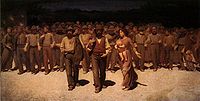- Giuseppe Pellizza da Volpedo
-
Giuseppe Pellizza da Volpedo (* 28. Juli 1868 in Volpedo; † 14. Juni 1907 ebd.) war ein Maler und Vertreter des italienischen Realismus.
Giuseppe Pellizza entstammte einer Familie von Bauern des südlichen Piemont, die ihr kleines Pachtgut im Zuge von Landreformen hatten erwerben können. Pelizza war Schüler der Accademia di Belle Arti di Brera. Beeinflusst wurde er von Giovanni Segantini. Er wandte sich hauptsächlich sozialen Themen zu.
Sein Monumentalgemälde Il quarto Stato (Der vierte Stand), welches er in den Jahren 1898–1901 malte und das 2,93 x 5,45 Meter groß ist, kann als Höhepunkt sozial engagierter realistischer Kunst Ende des 19. Jahrhunderts bezeichnet werden. Etwa zehn Jahre lang arbeitete Pellizza an diesem Thema. Seine Skizzen machte er unter anderem bei Kundgebungen und Streiks der Arbeiter während der großen Agrarkrise. Ihm gehe es nicht um die wirkliche Wirklichkeit, sondern um eine idealisierende Wirklichkeit. Das Gemälde wird als Denkmal der Arbeiterbewegung angesehen.
Am 14. Juni 1907 erhängte er sich in seinem Atelier unmittelbar vor seinem Gemälde Il quarto stato.
Bernardo Bertoluccis Film 1900 beginnt mit einer Eröffnungstotalen des Bildes.
Literatur
- Robert Darmstädter: Reclams Künstlerlexikon. Philipp Reclam jun., Stuttgart 1979, ISBN 3-15-010281-2
- „Labour, art and mass media: Giuseppe Pellizza's 'Il Quarto Stato' and the illustrated press“, in: Martina Hansmann und Max Seidel (Hrsg.): „Pittura italiana nell'Ottocento“; Venedig (Marsilio) 2005, S. 331-348
- Gabriele Mucchi: „"Der vierte Stand". Zu einem Gemälde von G. Pellizza“. In: „Bildende Kunst“, 5. Jahrgang, 1957, S. 177 - 178
- Aurora Scotti: „Pellizza da Volpedo. Catalogo generale“, Mailand 1986
Weblinks
- Informationen zu Giuseppe Pellizza da Volpedo im BAM-Portal
- Webportal zu Giuseppe Pellizza da Volpedo mit verschiedenen Links zu Leben, Werk und Wirkung (linke Spalte), italienischsprachige Seite, darunter jedoch auch ein Link mit deutschsprachiger Zusammenfassung („Die Welt des Pellizza zwischen Volpedo und Tortona“)
- einige Werke und Skizzen von Pellizza da Volpedo aus der Datenbank „Bilder der Arbeit“, Wuppertal (thumbnails zum Vergrößern anklicken)
- Humanität statt Sozialromantik
Wikimedia Foundation.


